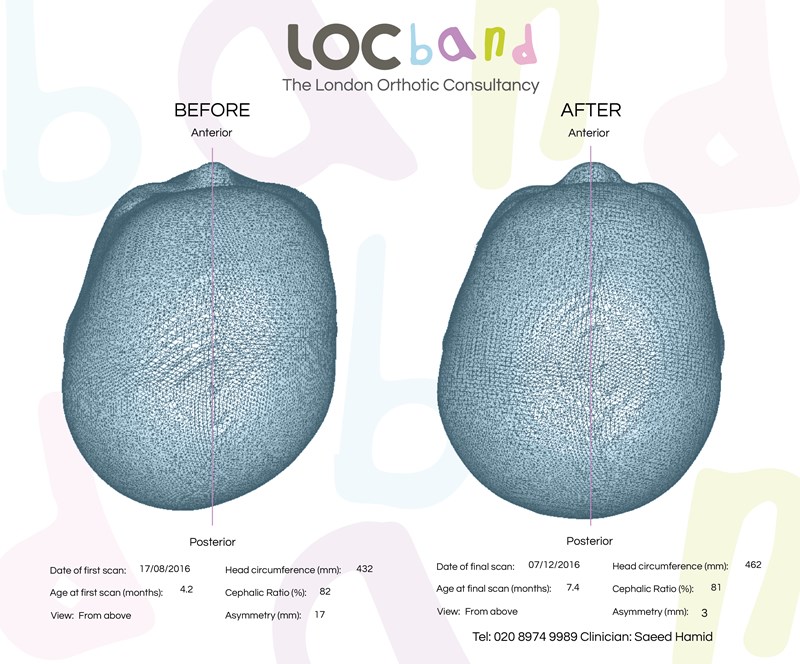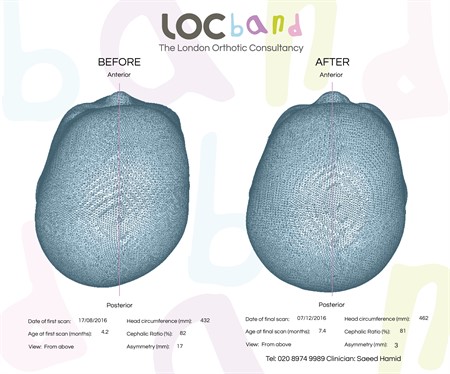
09 February 2017
Our daughter, M, was born with a noticeable flat head. I initially raised my concerns with our GP and our health visitor but was told several times not to worry and that it would improve over time; all I had to do was to reposition her head. Several weeks later and many frustrating and unsuccessful attempts at making M turn her head to the left we decided to get a second opinion. After an extensive Google search, I took M to see a physiotherapist who diagnosed a mild case of torticollis. I also took her to meet Saeed Hamid at the London Orthotics clinic in Harley Street to get a professional opinion on M’s head shape. M was 11 weeks at the time and while all my research indicated that she was far too young for a helmet, it was also very clear from many clinical studies that to be most efficient, and for the treatment length to be as short as possible it was paramount to start as early as possible, if at all possible before 20 weeks.
Saeed was extremely patient and courteous. He took M’s measurement which revealed a severe case of plagiocephaly at 14 mm. Far from ‘selling’ the helmet he advised to follow through with the physiotherapy routine and to continue repositioning her. We booked an appointment to review her progress at 16 weeks.
We met again when M was 16 weeks and further measurements confirmed my husband and I suspicion’s that her plagiocephaly had gotten worse. M was measuring at 17mm. By that time our decision was made. M was scanned that very same day and we booked a follow up appointment 2 weeks later for the fitting of the helmet.
At this point I want to say that it was not an easy decision to reach. While we were convinced that we were acting in M’s best interests we were obviously worried about making the wrong decision and subjecting her to an invasive and uncomfortable treatment. Hence the extensive online search we undertook. There are many studies available in medical journals and although most require paying a fee we read through most of them. This allowed us to accumulate sufficient knowledge to feel comfortable with this path. One other key factor was that the helmet is an orthosis, which means that if at any point we saw M being uncomfortable – or God forbid in pain – we were able to remove the helmet immediately and bring her relief.
M was 4 months when we went to her fitting appointment. The helmet only needed a small adjustment and we were given instructions to gradually increase the wearing time to full time wear (23 hours per day) as well as cleaning instructions. We also booked the following 5 appointments with Sally Hews who would be monitoring M’s progress and making the necessary adjustments to her helmet. The first few days were not the easiest ones for me. M was not bothered by the helmet and took to wearing it very easily. I, on the other hand, had to get used to not seeing my baby’s head which proved more difficult than anticipated. A week later we returned for our first adjustments and after that we saw Sally every 2 weeks for further measurements and adjustments. Sally expected the treatment to last for up to 4 months and we were aiming to reduce her asymmetry to about 5mm, just within the normal-mild range.
The timing of the fitting was perfect as shortly afterwards M went through a growth spurt so the helmet could gently re-direct the growth. In the end, M’s treatment lasted exactly 3 months and her asymmetry was reduced to 1.8mm, well within the normal range. M also had some facial asymmetry with her ears significantly misaligned and a visible bulge on her forehead. Both were greatly reduced and since taking off the helmet they have continued to improve to the point that no one (but me) notices it.
Wearing the helmet did not affect her sleeping at all. During treatment, we travelled to a hot weather destination and while we had to be careful not to let M overheat, she took it all in stride. I genuinely do not think that she noticed that she was wearing it.
Looking back, I am incredibly happy that we took action as early as we did and that we met with Saeed and Sally. During the whole process, they were always available to answer all the questions (I had quite a few) and provide reassurance and guidance. While we were on holiday I was even able to text them for advice. The care and attention they provided to M were second to none and were a key factor in making this experience an excellent one for M but also for us.
My husband and I would like to thank you for your help and your care. Our daughter’s head is now nicely rounded and we could not have hoped for a better outcome. We will continue to raise awareness about this condition and heartedly recommend Saeed Hamid and his team at the LOC.
Sam & Tim

If you are concerned about your baby’s head and would like a fast, free opinion from one of LOC’s experienced clinicians, you can use the LOC flat head diagnosis form to upload photos of your baby’s head and contact details. A LOC clinician will respond within 24 hours.
This is very much dependent on how fast your baby is growing. The faster the growth, the more frequently your baby will be seen so that the helmet can be adjusted. In general, reviews will happen at two to four-week intervals.
The price of treatment covers:
Yes - All babies that have completed their course of treatment with us have achieved a measurable improvement in head shape. However, you don’t have to take our word for it.
Recent independent research conducted by a University Hospital in Germany has endorsed the treatment for babies with moderate or severe plagiocephaly.
A larger, retrospective study has just been published that found complete correction was achieved in 94.4% of babies treated with helmet therapy.
The results were conclusive: repositioning achieved acceptable correction in 77.1% of cases, but 15.8% were moved onto helmet therapy because re-positioning was not working. Meanwhile, 94.4% of the infants who started in the helmet-treated group achieved full correction, as did 96.1% of those who were transferred from the repositioning group into the helmet-treated group.
Further information can be found on our Plagiocephaly Research page.
If your baby has a temperature or a fever due to illness you must remove the band. The band can be put back on once the temperature has returned to normal.
The optimum age for treatment is between four and seven months.
This is because the skull is most malleable at this age and improvements to head shape tend to take less time and are more dramatic. That is not to say that helmet therapy should be ruled out if the baby is older than seven months. Routinely, babies up to the age of 16 months can be treated very successfully.
The cut off age is around 18 months when the fontanelles (soft spots on the head) are no longer malleable. As babies grow and develop at different rates, it is always worth checking if you are not sure. There have been cases where a baby’s fontanelles have not fused yet by the age of 18 months, who have achieved successful, but less-marked results with cranial remoulding therapy.
Torticollis is a condition in which a tight or shortened muscle in one side of the neck causes the head to tilt or turn to one side, resulting in the infant resting its head in the same position. In 2013, we analysed the data from all first appointments in our Kingston clinic and found that 20% of the babies examined had some kind of neck condition that was causing head immobility.
The clinics and clinicians that provide this treatment in the UK will have received similar training and experience. However, we are the only clinic that manufactures its own helmet and our clinicians are closely involved with the process for each individual helmet that we produce.
In addition, we do not restrict review appointments to a set number, we are extremely flexible and respond to individual parents' needs so that the best outcome can be achieved for each baby.
The LOCband is non-invasive and works by applying gentle, constant pressure over the areas of the baby’s skull that are most prominent while allowing unrestricted growth over the flattened areas. The band consists of a soft foam layer inside a thermoplastic shell. As the baby grows, the band will be adjusted frequently to gently guide the skull into a more symmetrical shape.